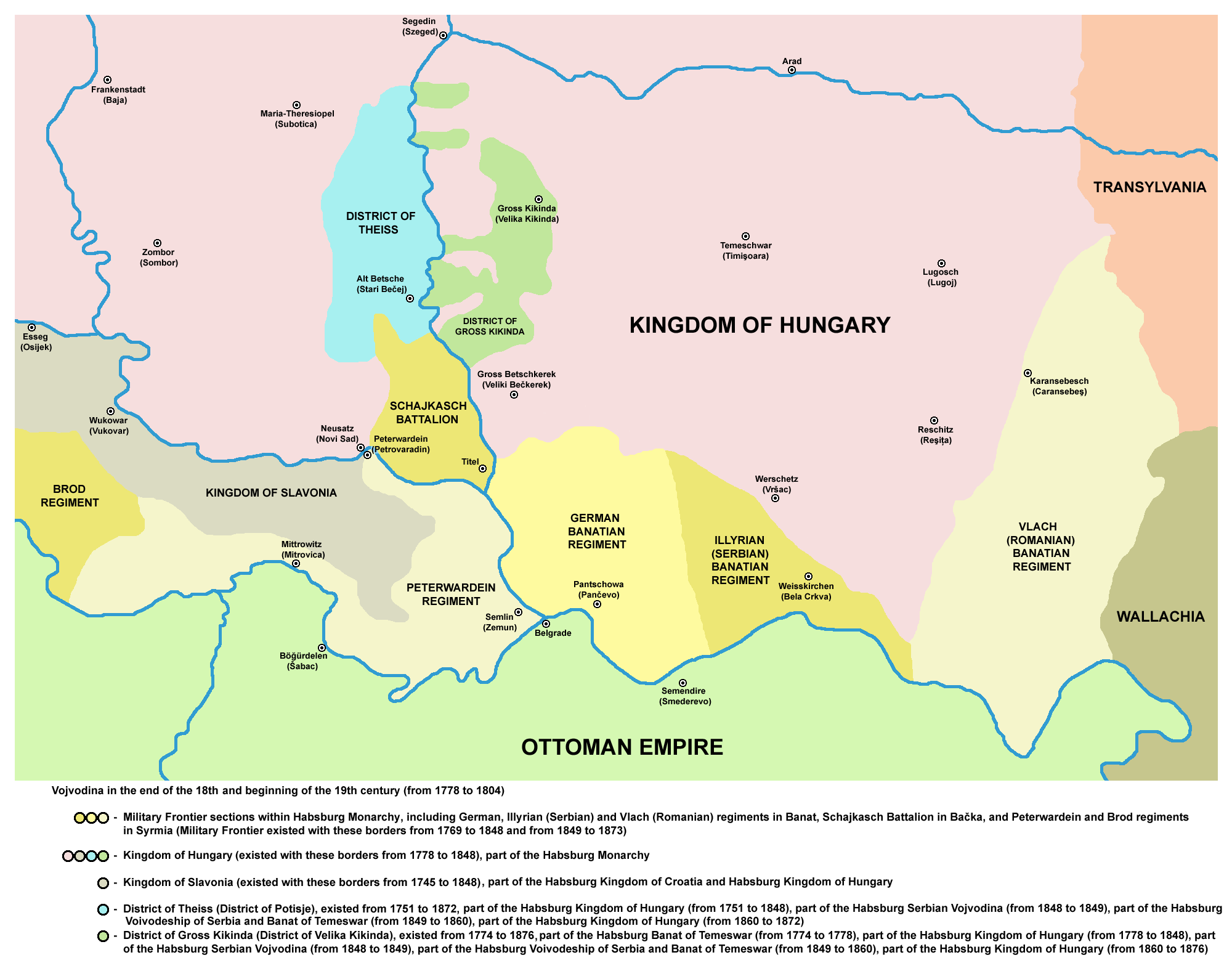|
Banat Of Temesvár
The Banat of Temeswar or ''Banat of Temes'' was a Habsburg monarchy, Habsburg province that existed between 1718 and 1778. It was located in the present day region of Banat, which was named after this province. The province was abolished in 1778 and the following year it was incorporated into the Habsburg Kingdom of Hungary (1526–1867), Kingdom of Hungary. Duality of name In the official documents of the time and also in all of native languages of the region, the name of the province appears in two basic forms, first derived from the name of Temeswar (Timișoara), second derived from the name of Temes County, Temes region: in German language, German - , Romanian language, Romanian - , Serbian language, Serbian - , , Hungarian language, Hungarian - and Latin language, Latin - . History Before the Habsburg province was established, several other entities had existed in the Banat region, including: the Glad (duke), Voivodeship of Glad (9th century), the Ahtum, Voivodeshi ... [...More Info...] [...Related Items...] OR: [Wikipedia] [Google] [Baidu] |
Habsburg Monarchy
The Habsburg monarchy (german: Habsburgermonarchie, ), also known as the Danubian monarchy (german: Donaumonarchie, ), or Habsburg Empire (german: Habsburgerreich, ), was the collection of empires, kingdoms, duchies, counties and other polities that were ruled by the House of Habsburg, especially the dynasty's Austrian branch. The history of the Habsburg monarchy can be traced back to the election of Rudolf I as King of Germany in 1273 and his acquisition of the Duchy of Austria for the Habsburg in 1282. In 1482, Maximilian I acquired the Netherlands through marriage. Both realms passed to his grandson and successor, Charles V, who also inherited the Spanish throne and its colonial possessions, and thus came to rule the Habsburg empire at its greatest territorial extent. The abdication of Charles V in 1556 led to a division within the dynasty between his son Philip II of Spain and his brother Ferdinand I, who had served as his lieutenant and the elected king of Hungary and ... [...More Info...] [...Related Items...] OR: [Wikipedia] [Google] [Baidu] |
Ahtum
Ajtony, Ahtum or Achtum ( hu, Ajtony, bg, Охтум, ro, Ahtum, sr, Ахтум) was an early-11th-century ruler in the territory now known as Banat in present Romania and Serbia. His primary source is the ''Long Life of Saint Gerard'', a 14th-century hagiography. Ajtony was a powerful ruler who owned many horses, cattle and sheep and was baptised according to the Orthodox rite in Vidin. He taxed salt which was transferred to King Stephen I of Hungary on the Mureș River. The king sent Csanád, Ajtony's former commander-in-chief, against him at the head of a large army. Csanád defeated and killed Ajtony, occupying his realm. In the territory, at least one county and a Roman Catholic diocese were established. Historians disagree on the year of Ajtony's defeat; it may have occurred in 1002, 1008 or between 1027 and 1030. His ethnicity is also a subject of historical debate; he may have been Hungarian, Kabar, Pecheneg or Romanian. In Romanian historiography Ajtony is viewed as ... [...More Info...] [...Related Items...] OR: [Wikipedia] [Google] [Baidu] |
Banat Krajina
The Banat Military Frontier or simply Banat Frontier ( sr, Банатска крајина/Banatska krajina; ro, Granița militară Bănățeană) was a district of the Habsburg monarchy's Military Frontier located in the Banat region. It was formed out of territories of the Banat of Temeswar. Today, the territory is split between Hungary, Serbia and Romania. Geography The Frontier was divided into Serb (''Illyrian''), German ('' Danube Swabian'') and Romanian (''Vlach'') sections. It included parts of modern-day Banat and the south-eastern part of Bačka region, known as Šajkaška. Some of the important cities and places were: Pančevo, Bela Crkva, Titel, Žabalj, Alibunar, Kovin, and Caransebeş. History The military province of Habsburg monarchy known as the Banat of Temeswar was created in 1718. In 1751, Maria Theresa introduced a civil administration for the northern part of the province. The southern part remained under military administration and was organized as the B ... [...More Info...] [...Related Items...] OR: [Wikipedia] [Google] [Baidu] |
Maria Theresa Of Austria
Maria Theresa Walburga Amalia Christina (german: Maria Theresia; 13 May 1717 – 29 November 1780) was ruler of the Habsburg monarchy, Habsburg dominions from 1740 until her death in 1780, and the only woman to hold the position ''suo jure'' (in her own right). She was the sovereign of Archduchy of Austria, Austria, Kingdom of Hungary, Hungary, Kingdom of Croatia (Habsburg), Croatia, Crown of Bohemia, Bohemia, Principality of Transylvania (1711–1867), Transylvania, Duchy of Mantua, Mantua, Duchy of Milan, Milan, Kingdom of Galicia and Lodomeria, Lodomeria and Galicia, the Austrian Netherlands, and Duchy of Parma, Parma. By marriage, she was Duchess of Lorraine, Grand Duchess of Tuscany and Holy Roman Empress. Maria Theresa started her 40-year reign when her father, Emperor Charles VI, died on 20 October 1740. Charles VI paved the way for her accession with the Pragmatic Sanction of 1713 and spent his entire reign securing it. He neglected the advice of Prince Eugene of Savoy, ... [...More Info...] [...Related Items...] OR: [Wikipedia] [Google] [Baidu] |

